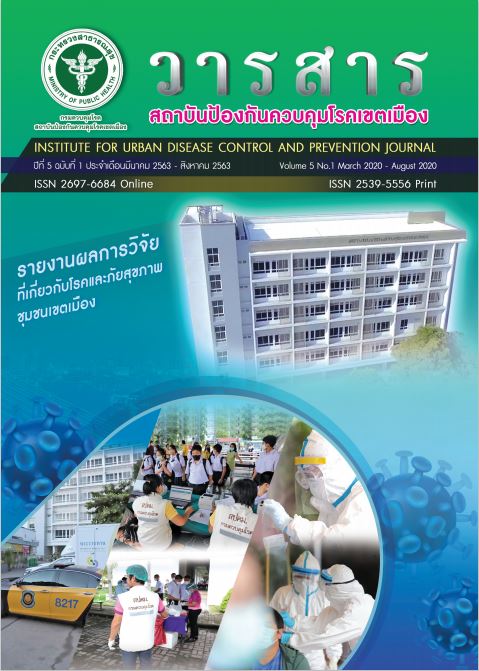ระดับความรอบรู้ด้านสุขภาพและหลักพฤติกรรมสุขภาพ 3อ.2ส.ของบุคลากรครูในโรงเรียนระดับมัธยมศึกษาแห่งหนึ่ง
Main Article Content
บทคัดย่อ
การวิจัยนี้เป็นการวิจัยเชิงสำรวจ เพื่อวัดระดับความรอบรู้ทางด้านสุขภาพและหลักพฤติกรรมสุขภาพ 3อ.2ส. และหาความสัมพันธ์ระหว่างปัจจัยส่วนบุคคล ความรอบรู้ด้านสุขภาพและพฤติกรรมสุขภาพ ของบุคลากรครู ระดับมัธยมศึกษา กลุ่มตัวอย่างเป็นบุคลากรครูระดับมัธยมศึกษา ณ โรงเรียนแห่งหนึ่ง จำนวน 114 คน ใช้แบบสอบถามในการเก็บรวบรวมข้อมูล ระหว่างเดือนธันวาคม 2562 ถึงเดือนมกราคม 2563 ได้รับแบบสอบถามกลับ100 ฉบับ (ร้อยละ 87.72) ใช้สถิติเชิงพรรณนา และค่าสัมประสิทธิ์สหสัมพันธ์แบบสเปียร์แมนในการวิเคราะห์ข้อมูล
ผลการวิจัยพบว่า ระดับความรอบรู้ทางด้านสุขภาพของบุคลากรครูโดยรวมอยู่ในระดับพอใช้ มีค่าคะแนนเฉลี่ย 69.03 พบว่าองค์ประกอบที่มีปัญหา 3 ลำดับแรกคือ การเข้าถึงข้อมูลบริการสุขภาพ การสื่อสารเพื่อเพิ่มความเชี่ยวชาญทางสุขภาพ และการจัดการเงื่อนไขของตนเองเพื่อเสริมสร้างสุขภาพอยู่ในระดับที่ไม่ดี ขณะที่พฤติกรรมสุขภาพอยู่ในระดับไม่ดี โดยมีคะแนนเฉลี่ย 21.83 ส่วนความแตกต่างระหว่างปัจจัยส่วนบุคคลของบุคลากรครูกับความรอบรู้ด้านสุขภาพและพฤติกรรมสุขภาพไม่แตกต่างกัน ด้านความสัมพันธ์ระหว่างความรอบรู้ด้านสุขภาพและพฤติกรรมสุขภาพของบุคลากรครู พบว่าการเข้าถึงข้อมูลและบริการสุขภาพ การจัดการเงื่อนไขของตนเองเพื่อเสริมสร้างสุขภาพ และความรอบรู้ด้านสุขภาพโดยรวมมีความสัมพันธ์ทางบวกค่อนข้างต่ำกับพฤติกรรมสุขภาพอย่างมีนัยสำคัญทางสถิติ
ข้อเสนอแนะจากการวิจัย ควรดำเนินการสกัดกั้นการเผยแพร่ข้อมูลทางสื่อออนไลน์ที่ไม่ถูกต้อง เช่น ข้อมูลเรื่องยา ผลิตภัณฑ์อาหารเสริม การอวดอ้างสรรพคุณ ซึ่งเป็นอันตรายต่อสุขภาพ โดยเชื่อมโยงการทำงานของกับหน่วยงานที่เกี่ยวข้อง ในการส่งเสริมความรอบรู้ด้านสุขภาพของบุคลากรครูให้เกิดความแตกฉาน ความเข้าใจ มีความรู้ความฉลาดทางสุขภาพเพื่อสุขภาพที่ดี การตัดสินใจเลือกเชื่อการโฆษณาหรือข้อมูลต่าง ๆ นำความรู้ไปใช้เป็นประโยชน์ต่อตนเองและต่อผู้อื่นด้วย
Article Details
บทความที่พิมพ์ในวารสารสถาบันป้องกันควบคุมโรคเขตเมือง ถือว่าเป็นผลงานวิชาการ งานวิจัยและวิเคราะห์ ตลอดจนเป็นความเห็นส่วนตัวของผู้เขียนเอง ไม่ใช่ความเห็นของสถาบันป้องกันควบคุมโรคเขตเมือง หรือคณะบรรณาธิการแต่ประการใด ผู้เขียนจำต้องรับผิดชอบต่อบทความของตน
เอกสารอ้างอิง
2. องค์การอนามัยโลก World Health Organization. Concepts and Examples in the Eastern Mediterranean Region. Individual Empowerment Conference Working Document. 7th Global Conference on Health Promotion Promoting Health and Development. Nairobi, Kenya.2009.(ระบบออนไลน์). เข้าถึงได้จาก file:///C:/Users /User/Downloads/112495-Article%20Text-288600-1-10-20180219.pdf (วันที่สืบค้นข้อมูล 2 ก.ค.2562)
3. สถาบันวิจัยระบบสาธารณสุข.นิยามศัพท์ส่งเสริมสุขภาพ.ฉบับปรับปรุง แปลโดยพิสมัยจันทวิมล: นนทบุรี; 2541.
4. สำนักยุทธศาสตร์การดูแลสุขภาพ (The Center for Health Care Strategies Inc.นิยามความรอบรู้ทางด้านสุขภาพ(2000).จากหนังสือความฉลาดทางสุขภาพ. กองสุขศึกษา กรมสนับสนุนบริการสุขภาพ กระทรวงสาธารณสุข. โรงพิมพ์นิวธรรมดาการพิมพ์ จำกัด. กรุงเทพ. พิมพ์ครั้งที่ 3; 2556.
5. Nutbeam D. Health literacy as a public health goal: a challenge for contemporary health education and communicaation strategies into health 21th century. Health Promotion International, Printed in Great Britain. 2000;15(8).
6. Mancuso (2008) (ระบบออนไลน์). เข้าถึงได้จาก https://onlinelibrary.wiley.com/doi/abs/10.1111/j.1442-2018.2008.00394. (วันที่สืบค้นข้อมูล 2 ก.ค.2562)
7. พิทยา ไพบูลย์ศิริ. ความรอบรู้ทางด้านสุขภาพและพฤติกรรมสุขภาพ 3อ.2ส. ของผู้บริหารภาครัฐ จังหวัดพระนครศรีอยุธยา วารสารสมาคมเวชศาสตร์ป้องกันแห่งประเทศไทย 2561; 8(1) 97-107.
8. องค์การอนามัยโลก (World Health Organization, 1998) World Health Organization. (1998). Promoting health through schools. Geneva: World Health Organization.
9. การสำรวจผู้ป่วยและผู้เสียชีวิตด้วยโรค NCDs ของประเทศไทยในปี 2553 – 2557. (ระบบออนไลน์). เข้าถึงได้จากhttp://www.thaihealth.or.th/microsite/categories/5/ncds/1/172/181+NCDs.html. (วันที่สืบค้นข้อมูล 2 พ.ย.2561)
10. สถานการณ์โรคไม่ติดต่อ. แผนยุทธศาสตร์การป้องกันและควบคุมโรคไม่ติดต่อระดับชาติ 5 ปี (พ.ศ.2560–2564) สำนักโรคไม่ติดต่อ กรมควบคุมโรค กระทรวงสาธารณสุข, 2557.
11. รายงานการสูญเสียปีสุขภาวะ (Disability-adjusted life years : DALYs ) รายงานภาระโรคและการบาดเจ็บของประชากรไทย ปี พ.ศ.2557 (ระบบออนไลน์). เข้าถึงได้จากhttps://www.voicetv.co.th/read/385677 (วันที่สืบค้นข้อมูล 2 พ.ย.2561)
12. Jennifer A. Manganello,2008.
13. DeWalt et al.,2004. การประเมินความสัมพันธ์ระหว่างความรู้เรื่องสุขภาพและผลลัพธ์ที่เกี่ยวข้องกับสุขภาพ.
14. Dean Schillinger และคณะ. “Closing the Loop : Physician Communication With Diabetic Patients Who Have Low Health Literacy” (ระบบออนไลน์). เข้าถึงได้จากhttps://translate.google.com/translate?hl=th&sl=en&u=https://profiles.ucsf.edu/dean.schillinger&prev=search (สืบค้นข้อมูล 2 ก.ค.2562)
15. นรรัชต์ ฝันเชียร.ทำอย่างไรให้ครูเป็นที่รักของนักเรียน. (ระบบออนไลน์). เข้าถึงได้จาก https://www.trueplookpanya.com https://www.trueplookpanya.com/education/content/71274/-teaartedu-teaart-teaarttea-สืบค้นเมื่อ 4 ก.ค. 2562.
16. สิทธิพร เอี่ยมเสน. มหาวิทยาลัยราชภัฏสวนดุสิต (ระบบออนไลน์). เข้าถึงได้จาก เข้าถึงได้จาก http://www.la-
orutis.dusit.ac.th/research14.php สืบค้นเมื่อ 2 ก.ค.2562.


